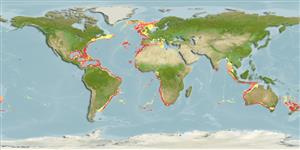Classification / Names
Common names from other countries
Main reference
Size / Weight / Age
Max length : 75.0 cm TL male/unsexed; (Ref. 5755); common length : 55.0 cm TL male/unsexed; (Ref. 9258); max. reported age: 104 years (Ref. 39263)
Length at first maturity
Lm 56.0 range ? - ? cm
Environment
Marine; bathydemersal; depth range 75 - 1200 m (Ref. 4738), usually 300 - 800 m (Ref. 4738)
Climate / Range
Deep-water, preferred 19°C (Ref. 107945); 65°N - 43°S
Distribution
North Atlantic: Iceland to the Canary Islands and Corner Seamounts. One specimen off North America (Ref. 7321). Southeast Atlantic, Indian and Southwest Pacific: Walvis Ridge off southwestern Africa to New Zealand.
Countries | FAO areas | Ecosystems | Occurrences | Introductions
Short description
Dorsal
spines
(total): 7 - 8;
Dorsal
soft rays
(total): 9-11;
Anal
spines: 2;
Anal
soft rays: 9. No opercular spines. 8 spines on first dorsal fin (Ref. 31632). Snout blunt, eye large. Mouth large, lower jaw equaling or slightly protruding beyond upper jaw. Pyloric caeca 21-34. Brown-violet or black, iridescent in life.
IUCN Red List Status (Ref. 115185)
Threat to humans
Harmless
Human uses
Fisheries: commercial
More information
ReferencesAquacultureAquaculture profileStrainsGeneticsAllele frequenciesHeritabilityDiseasesProcessingMass conversion
Tools
Special reports
Download XML
Internet sources
Estimates of some properties based on models
Phylogenetic diversity index
PD50 = 0.5000 many relatives (e.g. carps) 0.5 - 2.0 few relatives (e.g. lungfishes)
Trophic Level
3.6 ±0.3 se; Based on diet studies.
Resilience
Very Low, minimum population doubling time more than 14 years (tmax=104)
Vulnerability
High to very high vulnerability (70 of 100)
Price category
